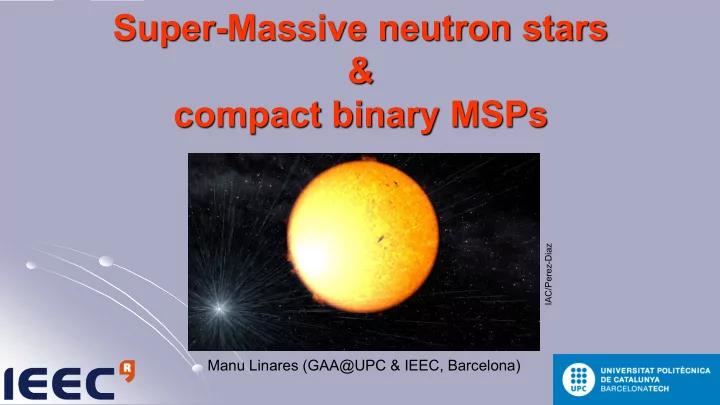

Super-Massive neutron stars & compact binary MSPs IAC/Perez-Diaz Manu Linares (GAA@UPC & IEEC, Barcelona)
WHAT IS THE MAXIMUM MASS OF A NEUTRON STAR? Astronomy: Neutron star mass measurements (binary pulsars) Astrophysics: Supernovae, NS birth mass, binary evolution, BH vs NS Gravitational waves: Outcome of NS+NS mergers (supra-massive NS?) Nuclear physics: Set by EoS in the core, where ρ core > ρ nuc (~2 x 10 14 g/cm 3 ) M. Linares, Bonn, 2020-02-17
Neutron Star Mass Mass Distribution Demorest/Fonseca 2010-16: 1.93+/-0.02 Msun (J1614-2230, WD, Porb=8.7 d) Antoniadis+ 2013: 2.01+/-0.04 Msun (J0348+0432, WD, Porb=2.46 hr) van Kerkwijk+ 2011: 2.40+/-0.12 Msun (B1957+20, BW, P orb =9.2 hr) Thorsett & Chakrabarty (1999, ApJ) 21+5 radio PSRs: 1.35 +/- 0.04 Msun Özel & Freire (2016, ARAA) 35-68 NSs in the 1.2-2.0 Msun range M. Linares, Bonn, 2020-02-17
Compact Binary Millisecond Pulsars A growing, nearby population of millisecond pulsars “Spiders” (blackwidows, BWs; redbacks, RBs): Millisecond pulsar R, γ (wind, γ -rays, spin-down luminosity: 10 34 -10 35 erg/s) O Binary, compact orbit (P orb ≤ 1 day; a ~ R Sun ) X Non/semi-degenerate companion star Bogdanov (low/very-low mass, RBs / BWs: ~0.1 / 0.01 M Sun ) COMPANION • Accreting past: maximum neutron star mass (van Kerkwijk+11, Linares+18) • Transitional MSPs: disk-wind-magnetosphere (Archibald+09, Papitto+13) • Evolution: link with low-mass X-ray binaries (Chen+13, Benvenuto+12) • Intra-binary shock: particle accel., cosmic rays (Bogdanov+11, Venter+15) M. Linares, Bonn, 2020-02-17
A Spider Revolution A booming field thanks to Fermi-LAT driven discoveries 4 (5% MSPs) 43 (20% MSPs) Field population x10 in ~10 years! [BWs/RBs: 3/1 29+1/14+10] d ~ 0.5-4 kpc; L sd ~ 10 34 -10 35 erg/s (Hessels, Roberts, Ray, Ransom+ PSC; Kong, Romani, Salvetti, …) M. Linares, Bonn, 2020-02-17
The Future is Bright Fermi-LAT: driving force and discovery space Acero et al. (2015, 3FGL) Successful LAT-driven searches in: RADIO / OPTICAL* / X-RAY / GAMMA-RAY More than 1300 unidentified GeV sources! *COBIPULSE: robotic optical multi-band (4FGL) photometric survey (N: 13/24, S:?/17) M. Linares, Bonn, 2020-02-17
PSR J2215+5135: 4.14 hr orbit Irradiated MS companion Massive NS? Breton+’13 Schroeder&Halpern’14 Romani+’15,16 IAC/Rosenberg Gran Telescopio CANARIAS (10.4 m) +WHT, IAC80
A Massive Neutron Star Dynamical Studies with Irradiation: PSR J2215+5135 K K K Balmer = 382.8 +/- 4.7 km/s M NS = 2.27 +/- 0.16 M Sun K Mg = 420.2 +/- 6.2 km/s T N =5660 +/- 320 K M 2 = 0.33 +/- 0.03 M Sun K 2 = 412.3 +/- 5.0 km/s T D =8080 +/- 375 K i = 63.9º +/- 2.5º 1) Extreme heating by 3) Physical model to find 2) Trace the velocity of pulsar wind: from G5 inclination and masses both sides using (cold/night side) to A5 (incl. constr. on T D , T N and different absorption lines (hot/day side)! q = M 2 /M 1 = K 2 P orb / 2 π x 1 c) (H vs Mg) M. Linares, Bonn, 2020-02-17
Neutron Star Mass Mass Distribution Thorset&Chakrabarty’99 Ozel&Freire’16 M < 2.15 M Sun R = 9.9 – 12 km Cromartie+19 (WD, P=4.8 d, Shap-del): M NS = 2.14 +/- 0.10 M Sun Compact Binary MSPs (Spiders): Key to find vKeerkwijk+11 Romani+15,16 the most massive neutron stars! Linares+18 Strader+19 M max > 2.3-2.4 M Sun !! M. Linares, Bonn, 2020-02-17
Massive Neutron Stars Impact on nuclear physics EQUATION OF STATE P(dens) + TOV M-R Only a ‘stiff’ EoS can support 2.3 M Sun (need enough pressure at the central densities) Hyperons don’t seem able to provide that pressure Özel & Freire (2016) M. Linares, Bonn, 2020-02-17
Massive Neutron Stars Impact on GW astronomy Margalit & Metzger (2017) NEUTRON STAR MERGERS Can they lead to super-massive neutron stars? Remnant & e.m. emission sensitive to M total / M max GW 170817: M total = 2.74 M Sun M max < 2.17 M Sun (Margalit & Metzger‘17); M max < 2.16-2.28 M Sun (Ruiz et al.’18) GW 190425: M total = 3.4 M sun Low-mass BHs vs. massive NSs (Chen et al.‘20) M. Linares, Bonn, 2020-02-17
Massive Neutron Stars Impact on GW astronomy COMPACT OBJECT MERGERS LIGO-Virgo/Frank Elavsky/Northwestern University Putting together EM and GW observations: Is there a “mass gap” between NSs and BHs? M. Linares, Bonn, 2020-02-17
Summary A Spider Revolution 4 43 in the past decade: Fermi-LAT • 20% of MSPs are BWs/RBs! • A 2.3 Solar-mass neutron star KEY: irradiation • NEW: empirical K correction (beat the heat) • Super-massive neutron stars 4/9 are spiders • IMPACT: ultradense matter, GW astronomy • M. Linares, Bonn, 2020-02-17
Recommend
More recommend